Where to Go and What to See
About Us
Safariing
Travelling
Accommodation
Equipment & Gadgets
Souvenirs
Clothing
Safari Activities
Coastal Activities
Security
Health
Where
When
Experiences
Slideshows
Evolution
Contacts
Site Map
Sub Site
|
|
The map shows most of the parks and reserves in East Africa. The balloons show how many times we've visited an area since Dec. 1994. We've not been to them all - it would take a lifetime, but we're working on it! Click on the balloons or select an area from the drop-down box to jump to a short description for each location. Use your web browser's [BACK] button to return to the map. |
|
Aberdares National Park, Ke |
||
Please follow this link to KWS' web page on Aberdares National Park. |
||
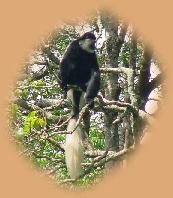 6th Sept. 2002 |
Note, many of the tracks can easily become impassable even in a 4-wheel drive vehicle during the frequent rainfalls. |
|
We have only been to the Aberdares once in June 2003, staying at the Ark for 3 nights. We were taken on an escorted safari with a private guide - now the extra expense is well worth it to travel with someone who knows the country and game as only a local can! By taking a few days in the park we were able to travel to the upper reaches where the terrain changes from tropical, through Alpine to Scottish Highlands. |
||
Amboseli National Park, Ke |
||
Please follow this link to KWS' web page on Amboseli National Park. |
||
The game, includes: Elephant (Amboseli is well known for its Elephants); Hippopotamus; Masai Giraffe; Cape Buffalo; Waterbuck; Wildebeest; Burchell's Zebra; Impala; Vervet Monkeys; Baboons; Hyena; Gerenuk (or Giraffe Gazelle); Grant's Gazelle; Thomson's Gazelle; Bohor Reedbuck; Warthog; Rabbits; Golden Jackal; Bat-eared Fox; Lion; Cheetah; Serval; Eland; Kudu; Beisa Oryx; Puff Adder; Crocodile; Ostrich; Marabou; African Jacana; Knob-billed Duck; Superb Starling; Helmeted Guineafowl; Goliath Heron; Egyptian Geese; Great White Pelican; Pied Kingfisher; Chestnut-bellied Sandgrouse; Cattle Egret; Tawny Eagle; Spur-winged Geese; Crowned Cranes; Little Egret; Lappet-faced Vulture; Oxpeckers; Blacksmiths Lapwing; Yellow Billed Stork; Sacred Ibis; Common Squacco Heron; Grey Heron; Great Egret; Black Headed Heron; Martial Eagle; Pale Eastern Chanting Goshawk; Kori Bustard. |
 22nd Jul. 2005 |
|
We have travelled to Amboseli on the following three occasions: |
||
West Chyulu Game Conservation Area, Ke |
||
Please follow this link to KWS' web page on Chyulu Hills Park. |
||
 19th Jun. 2004 |
The game is limited but includes: Thomson's Gazelle; Wildebeest; Masai Giraffe; Beisa Oryx; Grants Gazelle; Black-backed Jackal; Elephant; Gerenuk; Rock Hyrax; Lion. |
|
It was a pleasure travelling with friends who are passionate about their country and touring into areas they have known all their lives, especially with a customised Land Rover with all the field luxuries you need for a good sundowner! |
||
Lewa Wildlife Conservatory, Ke |
||
Please follow this link to Lewa's own web site. |
||
Lewa Downs is owned and run by the Craig family who have a number of properties and businesses established on the old ranch. As the name implies the area is covered by rolling grassy hills with few trees and swamps along the river. It is best known for its rhinoceros and Grevy Zebra breeding programmes. |
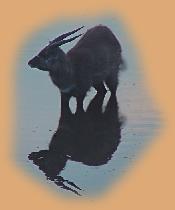 23rd Dec. 2002 |
|
We have been to Lewa twice: |
||
Loisaba, Ke |
||
Please follow this link to Loisaba's own web page. |
||
 2nd Jan. 2004 |
The property spans an escarpment above the Ewaso Ng'iro River, with the ranch on the plateau which is pretty flat open grassland. The landscape below the escarpment is of low rolling hills with trees and scrub for the game to hide in. |
|
There is a lot of game, including: Elephant; Burchell's and Grevy's Zebra; Reticulated Giraffe; Cape Buffalo; Defassa Waterbuck; Greater Kudu; Beisa Oryx; Eland; Impala; Grant's Gazelle; Gerenuk; Steenbok; Klipspringer; Dik-dik; Warthog; Lion ; Leopard; Cheetah; Wild Dog; Black-backed Jackal; Rock Hyrax; Ostrich; Kori Bustard; Black-chested Snake-Eagle; Brown Snake-Eagle ; Hamerkop; Dark Chanting-Goshawk; Pale Chanting-Goshawk; White-bellied Go-away-bird; White-bellied Bustard; Speke's Weaver; Rufous-crowned Roller; Red-billed Hornbill; Common Buzzard; Little Bee-eater; Superb Starling; Rosy-patched Bush-shrike; Grey-headed Kingfisher; Von der Decken's Hornbill (often woke us up at dawn with its constant pecking); Tawny Eagle; Vulturine Guineafowl; Straw-tailed Whydah; Verreaux's Eagle-Owl; Long-tailed Widowbird; Grey Crowned Cranes; Augur Buzzard; Martial Eagle; Tortoise; Terrapin. |
||
Lake Manyara National Park, Tz |
||
Please follow this link to Lake Manyara National Park. |
||
Lake Manyara is one of the series of soda (rather than fresh-water) lakes running through the Great Rift Valley. The park on its North Western shore is heavily wooded and best known for its tree-climbing Lions (we've only ever seen lions in trees in the Ngorongoro Crater!), trying to avoid the Tsetse flies that infest the area. |
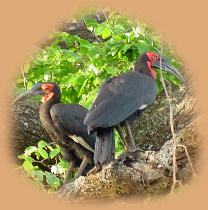 27th Dec. 2000 |
|
We've only ever visited Manyara on our first safari to Tanzania with a single night's stop-over on 27th Dec. 2000. |
||
Masai Mara, Ke |
||
Please follow this link to Masai Mara Conservation Reserve. |
||
 20th Jul. 2005 |
The Masai Mara (no it's not a typo Maasai is reserved for the race) is probably the most famous game park in the world - a must for anybody travelling to East Africa. Well frankly we consider it over-rated, as it has far too many beds in too small an area making it difficult to get any animal photos without other buses in the shot! On our last safari we passed a convoy of 20+ buses trailing outside Keekerok Lodge at 16:10 on their way towards the river to see the migration! Such volumes of traffic obviously damage the environment so the park wardens have to block-off large areas for long periods to allow it to recover. This forces all vehicles into other areas and consequently damaging that as well! |
|
Its popularity comes from the diversity of game and how easily it is spotted, including: Elephant; Rhinoceros; Hippopotamus; Masai Giraffe; Cape Buffalo; Burchell's Zebra; Eland; Wildebeest; Coke's Hartebeest (or Kongoni, as the locals like to refer to it); Topi; Impala; Grant's Gazelle; Thomson's Gazelle; Dik-dik; Baboon; Vervet Monkey; Lion; Cheetah; Leopard; Spotted Hyena; Black-backed Jackal; Warthog; Marsh Mongoose; Rock Hyrax; Monitor Lizard; Crocodile; Ostrich; African White-backed Vulture; Helmeted Guineafowl; Secretary Bird; Rufous-crowned Roller; Lilac-breasted Roller; Rüppell's Griffon Vulture; Grey Crowned Crane; Crowned Lapwing; Yellow-billed Stork; Marabou (Stork); Eastern Chanting-Goshawk; Wattled Starling; Sacred Ibis; Egyptian Goose; Woolly-necked Stork; Lappet-faced Vulture; Grey Heron; White-bellied Bustard. |
||
Meru National Park, Ke |
||
Please follow this link to KWS' web page on Meru National Park. |
||
There is a variety of game, including: Rhinoceros (in a segregated reserve); Reticulated Giraffe; Cape Buffalo; Common Waterbuck; Burchell's Zebra; Lesser Kudu; Impala: Grant's Gazelle; Dik-dik; Baboons; Lion; Black-backed Jackal; Rock Hyrax; Crocodile; Common and Somali Ostrich; African Fish Eagle; Martial Eagle; White Stork; Hamerkop; Grey-headed Kingfisher; Crowned Crane; Eastern Pale Chanting-Goshawk; Eastern Yellow-billed Hornbill; Red-billed Hornbill; Guineafowl. |
 30th Dec. 2004 |
|
We've only visited Meru once on a four night safari after visiting Samburu in December 2004. |
||
Nairobi National Park, Ke |
||
Please follow this link to KWS' web page on Nairobi National Park. |
||
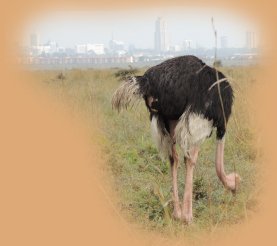 22nd Dec. 1994 |
Nairobi National Park is conveniently very close to the capital. Unfortunately as Nairobi expands it impacts on the park. So far the Western ring road runs alongside the SE boundary, but there are plans for the new Nairobi-Mombasa railway to cut the park in half. |
|
Considering all the years we have been travelling to East Africa we have only visited Nairobi National Park once, for a day on. 25th Dec. 2014. |
||
Lake Nakuru National Park, Ke |
||
Please follow this link to KWS' web page on Lake Nakuru National Park. |
||
Lake Nakuru is a soda lake in the middle of the Great Rift Valley and considered a real gem with a wide variety of game and birds. This park encompasses the whole lake and its surrounding forests providing a protected area covering a extensive habitat and therefore suitable for wide range of game. It is particularly known for its rhino and flamingos which turn the lake pink. |
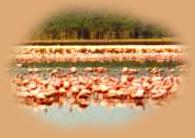 22nd Dec. 1994 |
|
We have only visited Nakuru on a fleeting visit for an afternoon during our first safari in December 1994. We are told this doesn't do it justice, as it needs longer to hunt down the more elusive animals, such as rhino. |
||
Ngorongoro Conservation Area, including the Crater, Tz |
||
Please follow this link to Ngorongoro Conservation Area. |
||
 24th Dec. 2000 |
Oldupai Gorge (better known as Olduvai Gorge - a misspelling by the earliest explorers to the area - oldupai is a wild variety of sisal that grows profusely in the area) is within the conservation area made famous by the Leakey's for discovering the earliest (at the time) evidence of man and his ancestors, including some footprints over 3.5 millions years old. The gorge itself looks like a jumble of rocks. |
|
The extensive game, includes: Elephant; Rhinoceros; Hippopotamus; Masai Giraffe; Cape Buffalo; Wildebeest; Defassa Waterbuck; Coke's Hartebeest (or Kongoni); Grant's Zebra ; Eland; Grant's Gazelle; Thomson's Gazelle; Reedbuck; Warthogs; Lion; Leopard; Cheetah; Serval; Spotted Hyena; Black-backed Jackal; Golden Jackal; Bat-eared Fox; Baboons; Vervet Monkey; Rock Hyrax; Python; Common Ostrich; Kori Bustard; Cattle Egret; Yellow-billed Egret; Augur Buzzard; Short-toed Eagle; Lappet-faced Vulture; Rüppell's Vulture; Greater and Lesser Flamingos; Marabou; White Stork; Yellow-billed Stork; Sacred Ibis; Egyptian Geese; Crowned Crane; Grey Heron; Hamerkop; White Pelican; Saddle-billed Stork; Black-bellied Bustard; Helmeted Guineafowl; Blacksmith's Plover; Southern Pochard; Yellow-throated Sandgrouse; Oxpeckers; Grey-headed Gulls. |
||
Ol Pejeta Conservancy, Ke |
||
Please follow this link to Ol Pejeta Conservancy. |
||
31th Dec. 2019 |
Ol Pejeta is located on the plains to west of Nanyuki. It comprises areas of low scrub, open plains and trees close to the water holes. | 29th Dec. 2019 |
The extensive game, includes: Elephant; Rhinoceros; Masai Giraffe; Cape Buffalo; Waterbuck; Coke's Hartebeest (or Kongoni); Grant's Zebra ; Eland; Grant's Gazelle; Thomson's Gazelle; Impala; Warthogs; Lion; Cheetah; Spotted Hyena; Black-backed Jackal; Hare; Kori Bustard; Fish Eagle; Cattle Egret; Windowbird; Vulture; Yellow-billed Stork; Crowned Crane; Sectretary Bird; Eastern Chanting Goshawk; Go-away Bird; Helmeted Guineafowl. |
||
Samburu and Buffalo Springs National Reserves, Ke |
||
Please follow this link to Samburu's web-site for background information on Samburu and Buffalo Springs. |
||
The game includes: Elephant; Hippopotamus; Reticulated Giraffe; Buffalo; Common Waterbuck; Beisa Oryx; both Burchell's and Grevy's Zebra; Gerenuk; Impala; Grant's Gazelle; Dik-dik; Baboon; Vervet Monkey; Lion; Leopard; Cheetah; Black-backed Jackal; Warthog; Marsh Mongoose; Dwarf Mongoose ; Rock Hyrax; Crocodile; Monitor Lizard; Tortoise; Turtle; Somali Ostrich; Kori Bustard; Marabou; Yellow-billed Stork; Secretary Bird; Grey Crowned Crane; Red-billed Hornbill; Bateleur (Eagle); Long-crested Eagle; Egyptian Geese; Vulturine Guineafowl; Eastern Pale Chanting-Goshawk; White-bellied Go-away Bird; Black-headed Heron; Yellow-necked Spurfowl; White-headed Buffalo-Weaver; White-crowned Shrike; Spur-winged Lapwing; Lilac-breasted Roller; Grey-headed Kingfisher. |
 7th Jan. 2000 |
|
We've safaried in both parks on the following occasions: |
||
Serengeti National Park, Tz |
||
Please follow this link to Serengeti National Park. |
||
 25th Dec. 2000 |
Depending on the migration cycle it attracts very similar game to the Masai Mara, but visitors are much scarcer as there are far fewer beds, spread over a much wider area. |
|
We've safaried to the Serengeti on two occasions: |
||
Shimba Hills National Reserve, Ke |
||
Please follow this link to KWS' web page on Shimba Hills National Reserve. |
||
Shimba Hills lies in the South Coast region of Kenya and runs parallel to the coast although 15-20 kms inland. As the name suggests the landscape is quite hilly with good views across the coastal plain. It has grassy meadows and woodland areas. There is one main lodge in the area, although it attracts many day visitors from the hotels along the coast. |
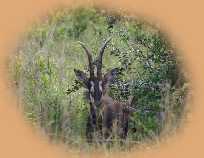 23rd Dec. 2000 |
|
We've only been to Shimba Hills once for four nights in Dec. 2009 before travelling on to Tsavo West. |
||
Shompole Conservancy, Ke |
||
Please follow this link to Shompole Conservancy. |
||
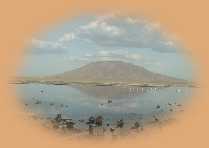 2rrd Dec. 2005 |
On one game drive we offered a herdsman who travelled each week between his village in Tanzania and the herd grazing on the Kenya side of the border. He covered the 60 miles on foot in a day, even during the soaring temperatures. |
|
We've only visited Shompole once on a five night safari in Dec. 2005. |
||
Tarangire National Park, Tz |
||
Please follow this link to Tarangire's website. |
||
Tarangire is situated in low hills and follows the Tarangire River and its many tributaries to the edge of Lake Burungi. The landscape is generally of wide grassy meadows, low scrub and areas of woodland. At many times of the year you'll need long sleeves, plenty of mozzie spray and handy rolled papers to fend off the abundant Tsetse flies infesting the area! |
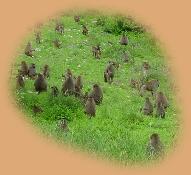 23rd Dec. 2000 |
|
We've been to Tarangire twice: |
||
Tsavo East National Park, Ke |
||
Please follow this link to KWS' web page on Tsavo East National Park. |
||
 29th Dec. 1998 |
If there has been little rain the game will congregate at the watering holes and along the river, but during wet periods it will disperse into the dense bush, when you'll have to help your driver in spotting. The game includes: Elephant; Rhinoceros; Hippopotamus; Masai Giraffe; Buffalo; Common and Defassa Waterbuck; Beisa Oryx; Wildebeest; Burchell's and Grevy's Zebra; Coke's Hartebeest (or Kongoni); Hirola (or Hunter's Hartebeest with straight horns - we were lucky to recognise it as others kept driving in Dec. 2006); Gerenuk; Impala; Grant's Gazelle; Thomson's Gazelle; Dik-dik; Lion; Leopard (finally spotted in Dec. 2010); Cheetah; Black-backed Jackal; Baboons; Vervet Monkey; Warthog; Rock Hyrax; Crocodile; Monitor Lizard; Agama Lizard; Tortoise; Common Ostrich; Kori Bustard; Marabou; Bateleur; Fish Eagle; Long-crested Eagle; Tawny Eagle; Secretary Bird; Brown Snake-Eagle; Spotted Eagle-Owl; Goshawk; Rüppell's Griffon Vulture; White Pelican; Grey Heron; Sacred Ibis; African Open-billed Stork; Egyptian Geese; Little Egret; Yellow-billed Stork; Spoonbill; Bustard; Helmeted Guineafowl; Hamerkop; Red-billed Quelea (flocking like the starlings in U.K.). | |
We've travelled to Tsavo East on ten occasions - the most we've visited anywhere. To some extent we use it as a reference, as we've travelled under many different conditions: dry; wet; after forest fires. |
||
Tsavo West National Park, Ke |
||
Please follow this link to KWS' web page on Tsavo West National Park. |
||
Tsavo West lies to the West of the Mombasa-Nairobi highway. Volcanic activity in the Chyulu Hills to the North makes this area much hillier than Tsavo East and generates a wider range of landscapes. Roughly in the middle we have Mizuma Springs which provides a plentiful supply of fresh water to Mombasa some 100 miles away. Landscapes range from volcanic rocky hills, grassy or dry meadows (depending on how much grazing occurs), thick bush and tree laden river courses. |
 14thJun. 2004 |
|